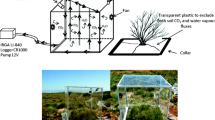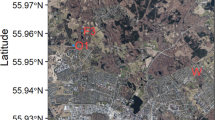Abstract
Closed (non-steady state) chamber measurements are often used to determine the gas exchange of N2O. Many researchers have addressed the underestimation of the emission estimates obtained from closed chamber measurements when using linear regression methods. However, the linear regression method is still usually applied to derive the flux. The importance of using non-linear regression methods is demonstrated with data from four fertilizing events each consisting of 1 month of automatic chamber measurements at Cabauw in the Netherlands in the period from July 2005 to July 2006. It is presented that the cumulative emission estimates with the exponential regression method are close to the cumulative emissions estimates with the intercept method. The linear estimates differ by up to 60% of the estimates with the exponential method. The performance of each method is validated using a C2H6 tracer and a goodness-of-fit analysis. The goodness-of-fit is much better for the exponential than the linear regression method. The systematic error due to linear regression is of the same order as the estimated uncertainty due to temporal variation. Therefore, closed-chamber data should be tested for non-linearity and an appropriate method should be used to calculate the flux.










Similar content being viewed by others
References
Anthony WH, Hutchinson GL, Livingston GP (1995) Chamber measurement of soil-atmosphere gas exchange: linear vs. diffusion-based flux models. Soil Sci Soc Am J 59:1308–1310
Beljaars ACM, Bosveld FC (1996) Cabauw data for the validation of land surface parameterization schemes. J Clim 10:1172–1193
Bothe H, Ferguson SJ, Newton WE (2007) Biology of the nitrogen cycle. Elsevier, The Netherlands
Chadwick DR, Pain BF, Brookman SKE (2000) Nitrous oxide and methane emissions following application of animal manures to grassland. J Environ Qual 29:277–287
Chatfield C (1997) Statistics for technology: a course in applied statistics. Chapman & Hall, UK
Christensen S (1983) Nitrous oxide emission from a soil under permanent grass: seasonal and diurnal fluctuations as influenced by manuring and fertilization. Soil Biol Biochem 15:531–536
Clayton H, Arah JRM, Smith KA (1994) Measurement of nitrous oxide emissions from fertilized grassland using closed chambers. J Geophys Res 99:16599–16607
Conen F, Smith KA (2000) An explanation of linear increase in gas concentration under closed chamber used to measure gas exchange between soil and the atmosphere. Eur J Soil Sci 51:111–117
Crutzen PJ (1981) Atmospheric chemical processes of the oxides of nitrogen, including nitrous oxide. Wiley, New York
Davidson EA, Savage K, Verschot LV et al (2002) Minimizing artifacts and biases in chamber-bases measurements of soil respiration. Agric For Meteorol 113:21–37
De Mello WZ, Hines ME (1994) Application of static and dynamic enclosures for determining dimethyl sulfide and carbonyl sulfide exchange in Spagnum peatlands: implications for the magnitude and direction of the flux. J Geophys Res 99:14601–14607
Eichner MJ (1990) Nitrous oxide emissions from fertilized soils: summary of available data. J Environ Qual 19:272–280
Flechard CR, Ambus P, Skiba U et al (2007) Effects of climate and management intensity on nitrous oxide emissions in grassland systems across Europe. Agric Ecosyst Environ 121:135–152
Gao F, Yates SR (1998) Laboratory study of closed and dynamic flux chambers: experimental results and implications for field application. J Geophys Res 103:26115–26125
Hansen S, Maehlum JE, Bakken LR (1993) N2O and CH4 fluxes in soil influenced by fertilization and tractor traffic. Soil Biol Biochem 25:621–630
Healy RW, Striegl RG, Russell TF et al (1996) Numerical evaluation of static-chamber measurements of soil-atmosphere gas exchange: identification of physical processes. Soil Sci Soc Am J 60:740–747
Hendriks DMD, Huissteden J, Dolman AJ (2007) The full greenhouse gas balance of an abandoned peat meadow. Biogeosciences 4:411–424
Hutchinson GL, Mosier AR (1981) Improved soil cover method for field measurement of nitrous oxide fluxes. Soil Sci Soc Am J 45:311–316
IPCC Climate change 2001 (2001) The scientific basis. Cambridge University Press, Cambridge
IPCC Climate change 1995 (2006) Scientific and technical analyses of impacts, adaptations and mitigation. Contribution of working group II to the second assessment report of the intergovernmental panel on climatic change. Cambridge University Press, London
Jager CJ, Nakken TC, Palland CL (1976) Bodemkundig onderzoek van twee graslandpercelen nabij Cabauw (in Dutch). NV Heidemaatschappij Beheer, The Netherlands
Kroon PS, Hensen A, Jonker HJJ et al (2007) Suitability of quantum cascade laser spectroscopy for CH4 and N2O eddy covariance flux measurements. Biogeosciences 4:715–728
Kutzbach L, Schneider J, Sachs T et al (2007) CO2 flux determination by closed-chamber methods can be seriously biased by inappropriate application of linear regression. Biogeosciences 4:1005–1025
Laville P, Jambert C, Cellier P et al (1999) Nitrous oxide fluxes from a fertilized maize crop using micrometeorological and chamber methods. Agric For Meteorol 96:19–38
Livingston GP, Hutchinson GL, Spartalian K (2005) Diffusion theory improves chamber-based measurement trace gas emission. Geophys Res Lett 32:L24817, doi:10.1029/2005GL024744
Livingston GP, Hutchinson GL, Spartalian K (2006) Trace gas emission in chambers: a non-steady state diffusion model. Soil Sci Soc Am J 70:1459–1469
Pederson AR, Petersen SO, Vinther FP (2001) Stochastic diffusion model for estimating trace gas emissions with static chambers. Soil Sci Soc Am J 65:49–58
Piphlatie M, Rinne J, Ambus P et al (2005) Nitrous oxide emissions from a beech forest Floor measured by eddy covariance and soil enclosure techniques. Biogeosciences 2:377–387
Ruser R, Flessa H, Schilling R et al (1998) Soil compaction and fertilization effects on nitrous oxide and methane fluxes in potato fields. Soil Sci Soc Am J 62:1587–1595
Veenendaal EM, Kolle O, Leffelaar P et al (2007) Land use dependent CO2 exchange and carbon balance in two grassland sites on eutropic drained peat soils. Biogeosciences 4:1027–1040
Acknowledgements
This research was part of the CarboEurope project and the Dutch BSIK program. We thank our colleagues P. Fonteijn, T. Schrijver and H. van ‘t Veen for their assistance during setting-up these experiments. We are also very grateful to E. de Beus of Technical University of Delft and G. Pieterse of University of Utrecht for their assistance in data analyses. D. Hendriks of University of Amsterdam and A. Schrier-Uijl of University of Wageningen are acknowledged for the discussions. Finally, we owe a special debt of gratitude to the KNMI and the farmer T. van Eyk for using their sites.
Author information
Authors and Affiliations
Corresponding author
Additional information
An erratum to this article can be found at http://dx.doi.org/10.1007/s10705-008-9224-9
Rights and permissions
About this article
Cite this article
Kroon, P.S., Hensen, A., van den Bulk, W.C.M. et al. The importance of reducing the systematic error due to non-linearity in N2O flux measurements by static chambers. Nutr Cycl Agroecosyst 82, 175–186 (2008). https://doi.org/10.1007/s10705-008-9179-x
Received:
Accepted:
Published:
Issue Date:
DOI: https://doi.org/10.1007/s10705-008-9179-x




